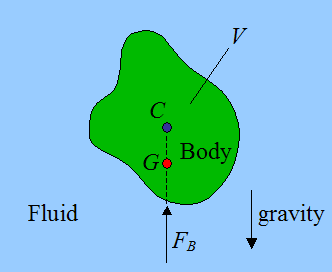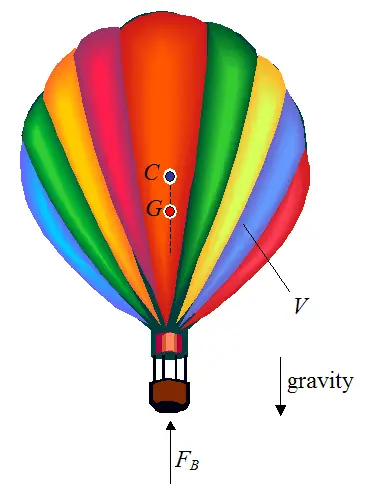Hot Air Balloon Physics

Source: http://www.flickr.com/photos/walkadog/3897126692
The basic principle behind hot air balloon physics is the use of hot air to create buoyancy, which generates lift. A hot air balloon consists of a large bag, called an envelope, with a gondola or wicker basket suspended underneath. A burner (with power typically of several megawatts) sits in the basket and is used to heat the air inside the envelope through an opening. This heated air generates lift by way of a buoyant force. The figure below shows a typical burner.

Source: http://www.flickr.com/photos/40509048@N00/2578740645
The hot air inside the envelope is less dense than the surrounding (cooler) air. This difference in density causes the hot air balloon to be lifted off the ground due to the buoyant force created by the surrounding air. The principle behind this lift is called Archimedes' principle, which states that any object (regardless of its shape) that is suspended in a fluid, is acted upon by an upward buoyant force equal to the weight of the fluid displaced by the object. So an object floating in water stays buoyant using the same principle as a hot air balloon. The figure below illustrates Archimedes' principle for an object completely submerged in a fluid (such as water, or air).

As shown in the figure above, the center of buoyancy acts through point C, which is the centroid of the volume V of the object. This volume is equal to the displaced volume of the fluid. The upward buoyant force FB is equal to the weight of the displaced volume of fluid V.
For the object to remain in an unconditionally stable orientation (i.e. not rotate) the center of mass of the object G must be directly below point C. This means that if the object were to be rotated by any amount, it will automatically rotate back to the original position where point G lies directly below point C. This is what is meant by unconditional stability.
For a hot air balloon, the upward buoyant force acting on it is equal to the weight (or mass) of the cooler surrounding air displaced by the hot air balloon. Since the air inside the envelope is heated it is less dense than the surrounding air, which means that the buoyant force due to the cooler surrounding air is greater than the weight of the heated air inside the envelope. And for lift to be generated, this buoyant force must exceed the weight of the heated air, plus the weight of the envelope, plus the weight of the gondola, plus the weight of passengers and equipment on board. As a result, the hot air balloon will experience sufficient buoyant force to completely lift off the ground.
As shown in the figure below, the weight of the hot air balloon is more concentrated near the bottom of the balloon (at the location of passengers and equipment), so the center of mass G of the hot air balloon is always below the center of buoyancy C. Therefore, the balloon is always stable during flight (i.e. it will always remain in the upright position).

Hot Air Balloon Physics – Operation
If the balloon operator wishes to lower the hot air balloon, he can either stop firing the burner, which causes the hot air in the envelope to cool (decreasing the buoyant force), or he opens a small vent at the top of the balloon envelope (via a control line). This releases some of the hot air, which decreases the buoyant force, which also causes the balloon to descend.
To maintain a steady altitude, the balloon operator intermittently fires and turns off the burner once he reaches the approximate altitude he wants. This causes the balloon to ascend and descend (respectively). This is the only way he can maintain an approximately constant altitude, since maintaining a strictly constant altitude by way of maintaining a net zero buoyant force (on the balloon) is practically impossible.
If the balloon operator wishes to move the balloon sideways (in a horizontal direction) he must know, ahead of time, the wind direction, which varies with altitude. So he simply raises or lowers the hot air balloon to the altitude corresponding to the wind direction he wants, which is the direction he wants the balloon to go.
The balloon stays inflated because the heated air inside the envelope creates a pressure greater than the surrounding air. However, since the envelope has an opening at the bottom (above the location of the burner), the expanding hot air is allowed to escape, preventing a large pressure differential from developing. This means that the pressure of the heated air inside the balloon ends up being only slightly greater than the cooler surrounding air pressure.
An efficient hot air balloon is one that minimizes the weight of the balloon components, such as the envelope, and on board equipment (such as the burner and propane fuel tanks). This in turn minimizes the required temperature of the air inside the envelope needed to generate sufficient buoyant force to generate lift. Minimizing the required air temperature means that you minimize the burner energy needed, thereby reducing fuel use.
Hot Air Balloon Physics – Analysis
Let's examine the physics of a hot air balloon using a sample calculation.
The heated air inside the envelope is at roughly the same pressure as the outside air. With this in mind we can calculate the density of the heated air at a given temperature, using the Ideal gas law, as follows:
P = ρRT
Where:
P is the absolute pressure of the gas, in Pa
ρ is the density of the gas, in kg/m3
R is the gas constant, in Joules/kg.K
T is the absolute temperature of the gas, in Kelvins (K)
Now,
Normal atmospheric pressure is approximately 101,300 Pa
The gas constant for dry air is 287 Joules/kg.K
The air inside the envelope is typically heated to an average temperature of about 100 degrees Celsius, which is 373 K
Substituting the above three values into the Ideal gas law equation and solving for ρ we get ρ = 0.946 kg/m3. This is the density of the heated air inside the envelope. Compare this to normal (ambient) air density which is approximately 1.2 kg/m3.
Next, for an average size balloon with an envelope volume of 2800 m3 we wish to determine the net upward buoyant force generated by the envelope.
The net buoyant force is defined here as the difference in density between the surrounding air and the heated air, multiplied by the envelope volume. Thus,
FB,net = (1.2−0.946)×2800 = 711 kg (1565 lb)
This is the net buoyant force pushing upwards on the heated air inside the envelope. The hot air balloon components (such as envelope, gondola, burner, fuel tanks, and passengers) can at most weigh 711 kg in order for the buoyant force to be able to completely lift the hot air balloon off the ground.
Closing Remarks
It's worth mentioning that hot air balloons are always quite large. This is because the envelope must contain a large enough volume of heated (lower density) air in order to generate sufficient upward buoyant force.
Thought Provoking Bonus Material
How many balloons are needed to lift a 40-lb child off the ground?
Can a lead balloon fly?
I created a physics analysis for these two problems, in PDF format. It's available through this link.
Return to Miscellaneous Physics page
Return to Real World Physics Problems home page
Free Newsletter
Subscribe to my free newsletter below. In it I explore physics ideas that seem like science fiction but could become reality in the distant future. I develop these ideas with the help of AI. I will send it out a few times a month.